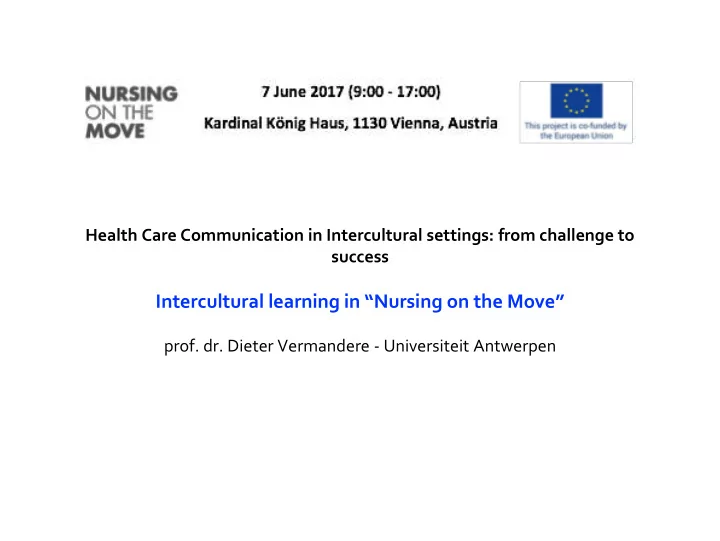

Health Care Communication in Intercultural settings: from challenge to success Intercultural learning in “Nursing on the Move” prof. dr. Dieter Vermandere - Universiteit Antwerpen
Main question for this session: “ how is intercultural • learning trained in NOM” ? structure of the talk: • explicitating the background notions • intercultural training: mix of ingredients • intercultural training in NOM: • concepts used • training tasks and goals •
1 | Background notions • Contemporary societies face the challenge of a growing diversity and heterogeneity of their population. • - Consequently, the traditional cross-cultural training that typically focused on knowledge of specific characteristics of a particular (foreign) “ national culture” is no longer sufficient. • these concepts are problematic • the NOM framework works with new concepts that underlie the intercultural training component
1.1 | the concept of “culture” • traditional notions relate to “national culture” as a fixed set of values and beliefs (= “ product ”) where “culture” has these characteristics: (see approaches like Hofstede, Trompenaers and others): • homogeneous : culture implies “national” unity and homogeneity • holistic : culture determines everything • exclusive : culture defines and therefore excludes • etiquette : culture is about surface behavior • stable : culture does not change •
contemporary research focuses more on the open or dynamic • interpretation of “culture” (= “ process ”) , where culture is understood as being: ▶︐ heterogeneous : there are different views within one “culture” (counter-culture) ▶︐ stratified : culture is layered: it’s a matter of degree ▶︐ specific : people can belong to different (sub)cultures ▶︐ meaningful :cultural behavior is communication = has communicative intent ▶︐ changing : cultures change as new problems require new solutions => this dynamic, flexible or open interpretation of culture as a “process” • makes it more difficult for training purposes, as there is no “fixed set” of categorial notions to work with
1.2 | “superdiversity” 1 ⃣ “national culture” is problematic, as cities are more “superdiverse” than ever before: big cities are majority-minority cities = the majority of their population is a • multitude of minorities 2 ⃣ there is no uniformity within the minorities: ▶︐ migrants from different areas (continents, countries, regions, …) ▶︐ migrants with different speeds (1st generation / 2nd / 3d / …) ▶︐ migrants with very different backgrounds (educated / poorly educated …) and different needs
1.2 | “superdiversity” 3 ⃣ there is much less uniformity within the majority reacting on these • minorities: ▶︐ different (sometimes opposing) social divides: - regional differences - political preferences - gender related preferences - religious orientations - social differences => this complex situation of cultural “fluidity” makes it very difficult to • “predict” cultural behavior based on “national cultural identity”
1.3 | “acculturation” 1 ⃣ previous trainings tended to focus on one-way “ cross-cultural ” comparisons: e.g. “gift-giving” among the Chinese community vs. the American community => with very little information about how these two communities interact when they meet 2 ⃣ current trainings focus on “ inter-cultural interaction ”: acculturation is a two-way process how to negotiate with different people from very different backgrounds, who are “new arrivals” in a host country who have to undergo acculturation into the host culture, and where the “host” also has to undergo acculturation to the new arrivals • = continuous process of “ two-way socialisation ” These concepts or notions open up new ways of training: different goals, • different methods => flexibility and dynamism are key
2 | Intercultural training 1 ⃣ Intercultural training used to focus extensively on “knowledge” of specific regions, areas, cultural habits etc. - e.g. Hofstede’s 6 dimensions, Trompenaers 9 dimensions, … 2 ⃣ contemporary intercultural training programmes are designed in a layered fashion:
▶︐ “ knowledge ”: of social processes and characteristics, cultural beliefs & habits, specific knowledge (medical …) ▶︐ “ attitudes ”: tolerance of ambiguity, openness, curiosity, behavioral flexibility, resilience, goal orientation, non- judgementalness ▶︐ “ skills ”: “soft skills” of interpreting and relating, building rapport, communication and interaction, cultural sensitivity 3 ⃣ meta-cognitive goal related to “ awareness raising ”: critical awareness of own behavior and perspectives related to acculturation
3 | Intercultural training in NOM 1︐ ⃣ using a flexible and dynamic interpretation of “culture” as “preferential ways of information exchange” thereby focusing on two -way communicative • interaction
2︐ ⃣ focus on communicative skills : presupposes an adequate level of linguistic • proficiency 3︐ ⃣ communicative skills trained in actual context goals: learning to negotiate and interact efficiently •
4︐ ⃣ how is this done? knowledge: 25 topics were identified • skills: “intercultural + communication” • the topics are linked to the language modules • and their specific functions e.g. “history taking” => intercultural communication tips on asking • questions (open ended questions to avoid Yes/No questions to which some patients always answer “Yes”)
⃣ focus on critical awareness (raising) from the 5︐ • point of view of the nurses: the “real life cases” • = complex and challenging scenarios where the • trainee has to reflect on a number of possible solutions and evaluate these in a specific context (e.g. a drunk patient)
Recommend
More recommend